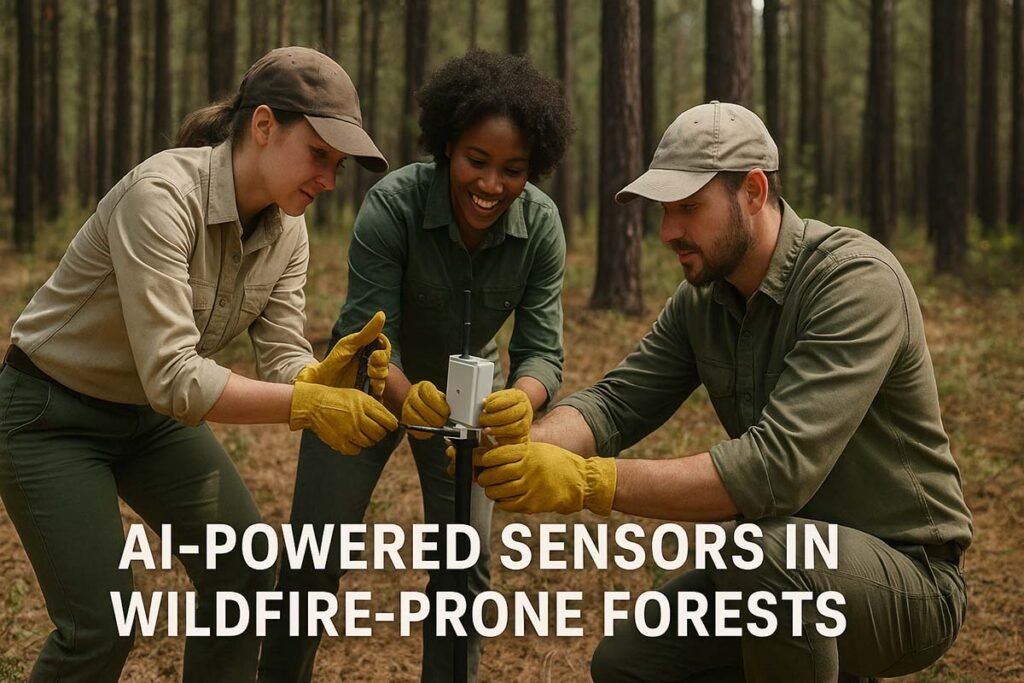AI Climate Solutions: Climate change is one of the most urgent challenges facing the United States and the world. Rising temperatures, wildfires, floods, and shifting weather patterns threaten communities, economies, and natural habitats. As the impacts grow, American scientists, innovators, and policymakers are turning to artificial intelligence (AI) for powerful new tools to monitor, predict, and mitigate these threats.
In 2025, US-led AI initiatives are unlocking breakthroughs in climate modeling, disaster forecasting, sustainable energy, and environmental protection. This post explores how AI is reshaping the nation’s approach to environmental stewardship—highlighting practical use cases, expert perspectives, and inspiring real-life US examples that offer hope for a greener future.
The US Landscape for AI and Climate Action
The Federal Push & Policy Environment
- The White House’s America’s AI Action Plan (July 2025) supports AI research for climate solutions and disaster resilience, allocating resources for both private innovation and government programs.
- Regulatory shifts aim to balance rapid AI infrastructure growth with environmental permitting—a complex challenge as policymakers debate water, energy, and ecosystem safeguards.
- Nonprofits like “Climate Change AI” bridge public and academic efforts, driving collaboration and open-source projects.
How AI Tackles Climate Change: 5 Key Impact Areas
1. Transforming Complex Systems
AI enables precise modeling and management of interconnected systems—power grids, transport, cities, and land use.
Example:
Google DeepMind’s wind energy optimization improved economic value by 20%, integrating renewable energy efficiently into US power grids.
2. Accelerating Discovery & Innovation
AI helps create new climate technologies—from advanced carbon capture systems to materials science breakthroughs.
- Protium Green Solutions uses AI to optimize green hydrogen production, slashing costs and boosting feasibility for widespread US renewable adoption.
3. Driving Behavior Change
AI empowers environmentally conscious choices for consumers.
Example:
Google Maps eco-routing helps US drivers choose routes that lower emissions, saving millions of tons of CO2 annually.
4. Improving Climate & Policy Modeling
AI enhances the accuracy of climate impact and policy simulations, offering real-time flood warnings, wildfire risk mapping, and better disaster management.
- Flood prediction models from CGI and University of Louisiana deliver advanced warnings by combining satellite, sensor, and AI analytics, protecting US communities and infrastructure.
5. Enhancing Adaptation & Resilience
AI supports vulnerable populations and regions, identifying risk hot spots and guiding resource allocation for climate adaptation.
- Drought forecasting combines AI with satellite data to help US farmers and planners tackle water scarcity and crop protection efforts.
Case Studies: Innovative US AI Projects in Climate Tech
AI-Powered Renewable Energy Management
- DeepMind’s algorithms forecast supply/demand and optimize integration of solar and wind, stabilizing national power grids and carving pathways for affordable renewables.
- Gridwise uses AI for real-time energy consumption management, aiding utilities in balancing loads and prioritizing green sources.
Disaster & Environmental Risk Prediction
- CGI partnered with University of Louisiana to launch machine learning-driven flood forecasting, improving soil moisture prediction and disaster readiness.
- NASA’s AI systems analyze satellite data to predict hurricanes, fires, and droughts, improving national response times.
Monitoring Pollution & Compliance
- Harvard’s AI-assisted climate models help predict air pollution impacts, informing tougher US air quality standards.
- UPenn research found that using machine learning, EPA inspectors could detect water pollution violations 600% faster than through random selection—making compliance more effective with limited resources.
Urban Sustainability & Smart Cities
- US cities like Los Angeles and New York employ AI for traffic optimization, energy planning, and green infrastructure decisions.
- AI analyzes traffic, public transit, and weather data to minimize emissions and optimize resource use.
Expert Opinions & Analysis
- Francesca Dominici, Harvard Data Science Initiative: “AI can harness mountains of data quickly, enabling better climate models and targeted public health interventions. However, we must also address the environmental footprint of AI—data centers consume significant energy, so ongoing efficiency improvements are critical.”
- Policy analysts stress US leadership in AI for climate must balance speed and innovation with robust environmental safeguards.
Comparisons & Tables
| Application Area | Traditional Methods | AI-enabled Solutions | Benefit |
|---|---|---|---|
| Climate Modeling | Manual data analysis, slow updates | Real-time, vast data processing | Faster, more accurate projections |
| Disaster Forecasting | Historical models, limited inputs | Multi-source AI analytics | Early warnings, improved protection |
| Energy Management | Static consumption forecasts | Adaptive, predictive optimization | Efficient, cost-effective green energy |
| Pollution Monitoring | Manual inspections, random sampling | AI-driven detection and predictions | Higher compliance, quicker enforcement |
| Consumer Interventions | Broad campaigns, limited feedback | Personalized recommendations, apps | Behavioral shifts, reduced emissions |
Overcoming Challenges: Risks & Solutions
- Data Center Footprint: US data centers supporting AI threaten to increase emissions; ongoing research focuses on smarter, energy-efficient hardware and greener cloud infrastructure.
- Equity and Accessibility: Federal and educational programs focus on bridging gaps in AI access for underserved communities to ensure fair benefits from climate tech.
- Policy Uncertainty: Transparency and public-private partnerships are vital to harness AI’s climate benefits while managing impacts on ecosystems and regulatory safeguards.
- Water & Energy Security: Experts urge careful oversight in scaling AI infrastructure to prevent resource exploitation, maintaining strong clean air and water standards.

Best Practices & Future Outlook
- Foster public-private partnerships (CGI, NASA, universities) to combine real-world data, funding, and technical expertise.
- Invest in AI literacy and workforce retraining, prepping Americans for green jobs in the climate tech sector.
- Expand open-access data and research initiatives to speed up innovation and spread benefits.
- Incorporate environmental impact assessments into all major AI infrastructure projects.
AI-powered climate technology is leading the next wave of US environmental innovation—from smarter disaster prediction and resilient infrastructure to cleaner energy and better policy work. The most promising initiatives combine rapid data analysis, practical modeling, and equitable solutions for vulnerable communities. As the US continues to invest and scale these projects, public collaboration, regulation, and transparency will shape a sustainable and hopeful climate future.
Want to be part of the climate solution? Stay informed, support AI-driven green programs, and encourage science-backed innovation in your community!
FAQs
Q1: How is AI helping the US fight climate change?
A1: AI aids US climate action by improving disaster forecasting, optimizing renewable energy, monitoring pollution, and powering smarter environmental policies.
Q2: What are examples of AI projects in US climate tech?
A2: Initiatives include Google DeepMind’s wind energy optimization, CGI’s flood prediction models, and EPA’s AI-based pollution tracking.
Q3: Are there risks to expanding AI for climate solutions?
A3: Yes, risks include data center energy use, water security, resource exploitation, and maintaining equity in access. These require ongoing attention and regulation.
Q4: Can AI help everyday Americans reduce their carbon footprint?
A4: Absolutely! AI apps like Google Maps recommend eco-friendly travel, smart home systems optimize energy use, and personalized tools guide sustainable choices.
Q5: What role does the US government play in climate-related AI?
A5: The White House and federal agencies support research, public-private partnerships, and policy design to scale up effective AI climate solutions.
Q6: Are there challenges in applying AI to climate action?
A6: Challenges include privacy, cost of scaling, need for high-quality data, and regulatory complexity—addressed through partnerships and policy reforms.




Pingback: Top AI-Enabled Consumer Devices in 2025: Smart Homes, Wearables & AR Gadgets - FirstsPost
Pingback: How AI is Enhancing US Public Safety: From Predictive Policing to Disaster Response - FirstsPost